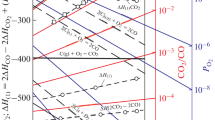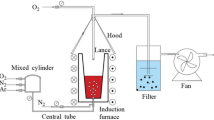Abstract
The article focuses on the study of the nature of dust and smoke generation in the gas-oxygen blowing of a converter bath. The main causes of metal waste are determined. The influence of the main parameters of the process on the loss of metal at the dust discharge and evaporation of iron in the reaction zone are studied. The metal pulverization due to floating CO bubbles is evaluated. This pulverization is determined by the rate at which they rise to the bath surface. The characteristic features of the temperature regime of the reaction zone and the heat balance upon the addition of fuel to the oxygen flow are determined. The addition of fuel to oxygen makes it possible to increase the heat input into the bath, while reducing the rate of decarburization. This favors the reduction in the amount of discharged dust formed at the rupture and crushing of metal films by gas bubbles. The influence of using combustion product oxygen on the oxidation of metal impurities is considered. The blowing of carbon and alloyed steel for mill rollers is used as an example to show that the main qualities of gas-oxygen blowing are the decomposition degrees of CO2 and H2O in the bath. These indicators determine the oxidizing and heating properties of the air blast. The change in the total, consumed heat and its losses with exhaust gases are evaluated, depending on the degree, to which the oxygen flow is diluted with natural gas (methane). In these conditions, the use of submersible combustion torches with the change in their oxidizing ability makes it possible to solve various process tasks, including the provision of an efficient procedure of reducing dust emission in the converter process.





Similar content being viewed by others
REFERENCES
Baptizmanskii, V.I., Medzhibozhskii, M.Ya., and Okhotskii, V.B., Konverternye protsessy proizvodstva stali (Converter Steelmaking Processes), Kiev: Vishcha Shkola, 1984.
Kolpakov, S.V., Starov, R.V., Smoktii, V.V., et al., Tekhnologiya proizvodstva stali v sovremennykh konverternykh tsekhakh (Steelmaking Technology in Modern Converter Plants), Moscow: Mashinostroenie, 1991.
Baptizmanskii, M.I., Boichenko, B.M., and Cherevko, V.P., Teplovaya rabota kuslorodnykh konverterov (Thermal Operation of Oxygen Converters), Moscow: Metallurgiya, 1988.
Li, M., Li, L., Zhang, B., Li, Q., Wu, W., and Zou, Z., Numerical analysis of the particle-induced effect on gas flow in a supersonic powder-laden oxygen jet, Metall. Mater. Trans. B, 2020, vol. 51, no. 4, pp. 1718–1730. https://doi.org/10.1007/s11663-020-01855-3
Ashrit, S., Sarkar, S., Chatti, R.V., Sarkar, C., and Sarkar, S., Nonmetallic LD slag fines—opportunities by invoking chemistry, Ironmaking Steelmaking, 2020, vol. 47, no. 8, pp. 903–907. https://doi.org/10.1080/03019233.2019.164167
Wang, B., Shen, S., Ruan, Y., Cheng, S., Peng, W., and Zhang, J., Simulation of gas-liquid two-phase flow in metallurgical process, Acta Metall. Sin., 2020, vol. 56, no. 4, pp. 619–632. https://doi.org/10.11900/0412.1961.2019.00385
Yao, L., Zhu, R., Tang, Y., Wei, G., and Dong, K., Effect of furnace gas composition on characteristics of supersonic oxygen jets in the converter steelmaking process, Materials, 2020, vol. 13, no. 15, art. ID 3353. https://doi.org/10.3390/ma13153353
Sharma, S.K., Hlinka, J.W., and Kern, D.W., The bath circulation, jet penetration and high-temperature reaction zone in BOF steelmaking, Steelmaking Proc., 1977, vol. 60, pp. 181–197.
Yavoiskii, V.I., Teoriya protsessov proizvodstva stali (Theory of Steelmaking Processes), Moscow: Metallurgiya, 1969.
Okhotskii, V.B., Fiziko-khimicheskaya mekhanika staleplavil’nykh protsessov (Physicochemical Mechanics of Steelmaking Processes), Moscow: Metallurgiya, 1993.
Fedorchenko, I.M. and Andrievskii, S.A., Osnovy poroshkovoi metallurgii (Fundamentals of Powder Metallurgy), Kiev: Akad. Nauk SSSR, 1963.
Barella, S., Mapelli, C., Mombelli, D., Gruttadauria, A., Laghi, E., Ancona, V., and Valentino, G., Model for the final decarburization of the steel bath through a self-bubbling effect, Ironmaking Steelmaking, 2019, vol. 46, no. 8, pp. 721–724. https://doi.org/10.1080/03019233.2017.1405179
Jacobs, H., Q-BOP process—after eleven years, Metals, 1973, vol. 25, no. 3, pp. 33–41.
Li, W., Zhu, R., Feng, C., Wei, G., and Han, B., Influence of carrier gas of converter oxygen lance on smooth distribution of O2–CO2–CaO mixed jet, Trans. Indian Inst. Met., 2020, vol. 73, no. 12, pp. 3027–3035. https://doi.org/10.1007/s12666-020-02105-5
Osani, H. and Ohmiya, S., Total hot metals pretreatment and BOF operation practice for high purity steelmaking, Proc. 1st EOS Congr., Düsseldorf, 1993, pp. 41–46.
Jamamoto, Z., Production and technology of iron and steel in Japan during 1993, ISIJ Int., 1994, vol. 34, no. 4, pp. 299–312. https://doi.org/10.2355/isijinternational.34.299
Somways, N.L., Development in the North-American iron and steel industry, Iron Steel Eng., 1994, vol. 71, no. 2, pp. 1–20.
Filippov, S.I. and Kol’tsov, A.T., Oxygen partial pressure distribution along a multiphase blast stream of oxygen converter, Izv. Vyssh. Uchebn. Zaved., Chern. Metall., 1979, no. 9, pp. 33–36.
Medzhibozhskii, M.Ya., Osnovy termodinamiki i kinetiki staleplavil’nykh protsessov (Fundamentals of Thermodynamics and Kinetics of Steelmaking Processes), Kiev: Vishcha Shkola, 1979.
Protopopov, E.V., Solomon, G.M., and Verevkin, G.I., State of slag-metal emulsion and changes in physicochemical properties during melting in an oxygen converter, Izv. Vyssh. Uchebn. Zaved., Chern. Metall., 1995, no. 8, pp. 25–27.
Goodman, N., Slag splashing of BOF converters, Iron Steel Inst., 1996, vol. 30, pp. 24–33.
Diepmann, D. and Gharib, M., The role of streamwise vorticity in the near-field entrainment of round jets, J. Fluid Mech., 1992, vol. 245, pp. 643–668.
Protopopov, E.V., Aizatulov, R.S., and Chernyatevich, A.G., Technological aspects of combined supply of inert gas to converter bath, Trudy IV Mezhdunarodnogo kongressa staleplavil’shchikov (Proc. IV Int. Congr. of Steelmakers), Moscow: Chermetinformatsiya, 1997, pp. 104–107.
Protopopov, E.V., Chernyatevich, A.G., and Yudin, S.V., Investigation of chemical and temperature gradients in a converter bath using high-temperature modeling, Izv. Vyssh. Uchebn. Zaved., Chern. Metall., 1997, no. 10, pp. 20–24.
Lushka, A.I., Osnovy khimicheskoi termodinamiki i kinetiki khimicheskikh reaktsii (Fundamentals of Chemical Thermodynamics and Kinetics of Chemical Reactions), Moscow: Mashinostroenie, 1981.
Karp, I.N., Soroka, B.S., Dashevskii, L.N., and Semernina, D., Produkty sgoraniya prirodnogo gaza pri vysokikh temperaturakh (Products of Natural Gas Combustion at High Temperatures), Kiev: Tekhnika, 1967.
Author information
Authors and Affiliations
Corresponding authors
Additional information
Translated by S. Kuznetsov
About this article
Cite this article
Solonenko, V.V., Protopopov, E.V., Temlyantsev, M.V. et al. Nature of Dust and Smoke Generation at Gas-Oxygen Blowing in a Converter Bath. Steel Transl. 51, 79–87 (2021). https://doi.org/10.3103/S096709122102008X
Received:
Revised:
Accepted:
Published:
Issue Date:
DOI: https://doi.org/10.3103/S096709122102008X




